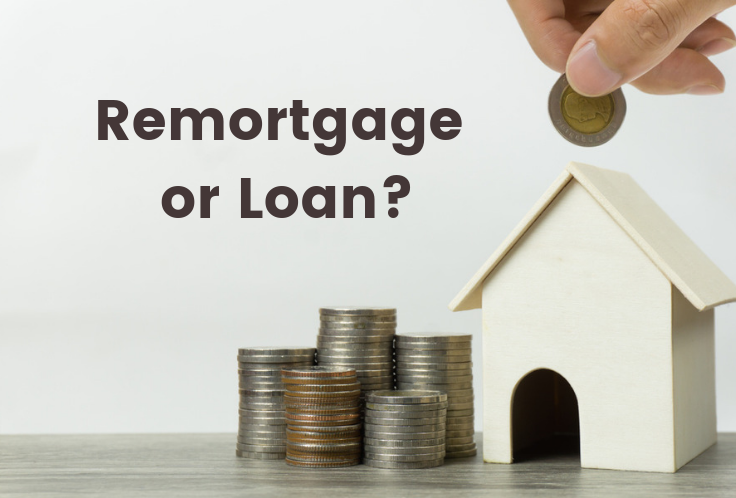You are the happy owner of a property, but you decide you would like to make some home improvements around the house. Whether this be an extension, redecorating or re-tiling the roof, it is going to be an expensive job – something many homeowners don’t necessarily have lying around once their mortgage and bills have been paid. Therefore, you may be deciding what the best plan of action is best for you. In this post, we answer the burning question, “should I remortgage or get a loan?”
When it comes to funding a home improvement, there are three main options available:
- Remortgage your property
- Get a second mortgage
- Apply for an unsecured loan
But before you think of remortgaging your home, it is worth speaking to your existing mortgage lender to ask if they are prepared to lend you any extra money for your home improvement needs. This is a good idea if your existing deal has low interest rates and you would like to stick with your current provider.

1. Remortgaging your property
If you are thinking of remortgaging your home, the process is fairly straightforward. But you’ll need to be aware that by remortgaging, you’ll be increasing the amount of borrowing secured against your home. Not to mention your mortgage payments may increase over the full term of your mortgage, so evaluate whether the increase in money each month will be suitable when you’re older.
Furthermore, remortgaging means you may also have to pay fees associated with remortgaging, so find out how much you will need to pay when you consider whether it is a feasible option for you.
2. Applying for a second mortgage
Another option is to keep your existing mortgage running and finding another lender who is prepared to approve a second mortgage. This is only viable if you have enough money in the bank to pay for both mortgage payments over several years.
You should be aware that this option increases the amount of borrowing that’s secured against your home, and a second charge mortgage may also be offered at a rate that is much higher than your existing mortgage.
3. Taking out an unsecured loan
If you don’t want to secure additional borrowing against your home, you could try applying for an unsecured personal loan from the bank or other lender. These types of loans typically have repayment terms of up to five years, and usually have fixed interest rates, which can be helpful when planning your finances for the future. Just make sure you can keep up with the monthly repayments, which are usually higher than monthly mortgage repayments in the short term.

Should I remortgage or get a personal loan? What’s the difference?
Put simply, remortgaging is another term for refinancing. If you choose to remortgage your property, you pay off your current mortgage first with a second mortgage which offers a lower interest rate or better terms.
Remortgaging may sound complicated, but it is common practice for homeowners with a good credit score that has increasingly improved. If your home’s value has increased or you’ve simply found a lender offering a better deal than your current mortgage, you may be able to save thousands of pounds in interest over the long term while reducing your monthly payments.
The remortgaging process is similar to taking out a mortgage than borrowing money with a personal loan. When choosing between a personal loan or remortgage, the better option depends entirely on what you need the loan to do. Remortgaging is ideal for specific goals — like lowering the monthly payments on your house or switching to a fixed-rate mortgage — while a personal loan is designed to cover costly purchases without restrictions. Approval for both usually depends on a decent credit score and a history of timely payments.

It’s worth bearing in mind that if you decide to borrow any money for your home, there is always a risk that you may lose your house further down the line if you fail to keep up with payments – this is particularly the case if you decide to take on a second mortgage. Therefore, it is vital to bear this in mind when considering your options and consult a financial adviser to help you.
So, if you’re considering taking out a homeowner loan or remortgaging your home, ask yourself these questions:
- Are you confident that you can afford the monthly repayments?
- If you’re trying to save, is the amount you need an achievable goal?
- Are the home improvements really necessary?
Alternatively, if you find you are unable to afford to get a loan or remortgage your home, you next best bet might be to sell your house for cash and move into a larger home instead. We buy houses for cash at Sellhousefast.uk – get in touch with the team if you need any advice.
Feature image credit: INDz / Shutterstock




